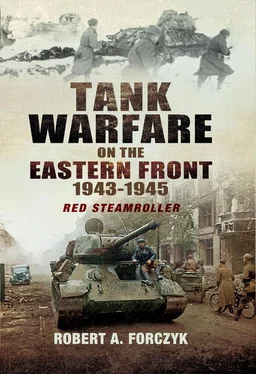Vormann’s 23.Panzer-Division tried to mount a defence of the rail station at P’yatykhatky, but this effort fell apart and Soviet tanks reached the virtually undefended town at 2030 hours on 18 October. At the train station, the Soviet desant troops on the T-34s discovered flatcars loaded with 10 brand-new Tiger tanks, destined for Großdeutschland . {191} Another train in the station was discovered loaded with wounded German troops, who were unceremoniously dispatched by the victorious Soviet Desantniki with grenades and small arms. Meanwhile, a massive column with over 3,000 German vehicles was fleeing from the as yet unoccupied southern side of the town. Spotting the escaping enemy, Soviet T-34s fired high explosive rounds into the column, inciting a panic. {192} Vormann’s 23.Panzer-Division was wrecked, with only 10 tanks left, 30 men in Panzergrenadier-Regiment 126 and 29 in Panzergrenadier-Regiment 129. Having shattered the connection between PzAOK 1 and AOK 8, Konev was faced with the decision of whether to push west to Kirovograd to roll up AOK 8’s right flank or south to Krivoi Rog, to threaten PzAOK 1’s line of communications. He opted to split his forces and attempt to seize both objectives: Skvortsov’s 5 GMC and the 53rd Army would push toward Kirovograd while the 18 TC and 29 TC advanced to Krivoi Rog. The Germans were literally reeling from the Soviet armoured breakthrough and resistance was patchy, which allowed the 5 GMC to reach Novo Starodub on the Inhulets River on 22 October and the rest of Rotmistrov’s 5 GTA reached the outskirts of Krivoi Rog on 27 October. Mackensen’s PzAOK 1 was threatened with envelopment by the Soviet advance, which forced him to abandon Dnepropetrovsk on 25 October. Malinovsky’s 3rd Ukrainian Front swarmed across the Dnepr with three armies.
Time and again, the Germans proved themselves adept at recovering from tactical setbacks, just as the Soviets demonstrated great difficulty in logistically sustaining deep armoured penetrations. Fortuitously, Rotmistrov’s fuel supplies in his forward tank brigades dwindled just as the Germans received powerful armoured reinforcements from the West. Both the 14. and 24.Panzer-Divisionen had been destroyed at Stalingrad in February, but now eight months later they reappeared on the Eastern Front. These units were the first of a new breed of watered-down Panzer-Divisionen, each equipped with 49 Pz IV tanks and 44 StuG III assault guns, configured primarily for mobile defensive operations. Von Manstein directed both fresh Panzer-Divisionen to assemble in Kirovograd. Major Willing’s s.Pz.Abt.506 was sent from Zaporozhe to defend Krivoi Rog. The 11.Panzer-Division and Totenkopf were also moved to support this sector. General der Panzertruppe Sigfrid Henrici’s XXXX Panzerkorps took control over the bulk of these forces and began planning a counter-attack to cut off Rotmistrov’s spearheads. However, only a week before the German counter-offensive was to begin, Henrici was sent into the Fuhrer Reserve and the XXXX Panzerkorps was handed over to General der Gebirgstruppen Ferdinand Schörner, who was flown in from Finland. This was an amazing example of Hitler’s interference in tactical matters. Not only did Schörner have no experience with mechanized operations, but he also had no experience with combat in the main war zone in Russia. Yet Hitler had not chosen Schörner randomly. He was selected because of his fanatical command style and devotion to the Nazi regime. When the chips were down, Hitler chose political reliability over professional skill.
Only days after taking command, Schörner ordered the counter-attack to begin immediately, even though only parts of the 14. and 24.Panzer-Divisionen had arrived. On 28 October, Totenkopf kicked off the attack against Skvortsov’s 5 GMC with 5 Tigers and a handful of other tanks, while 11.Panzer-Division attacked Rotmistrov’s spearhead near Krivoi Rog. The next day, those parts of the 14. and 24. Panzer-Divisionen that were available joined in. Rotmistrov was caught flat-footed, not expecting to be struck by fresh enemy armoured divisions and his 5 GTA recoiled from Krivoi Rog after suffering heavy losses. The German armoured counter-attack plugged the gap between PzAOK 1 and AOK 8, but a great opportunity had been squandered by Schörner, who unimaginatively opted to push the enemy salient back, rather than cut it off. Had these four Panzer-Divisionen been properly coordinated, the XXXX Panzerkorps might have cut off and destroyed at least two of Rotmistrov’s three corps. Instead, Hitler and Schörner opted for an ordinary victory.
As October 1943 drew to a close, Konev and Malinovsky were across the Dnepr in strength, but Vatutin had been stymied for weeks. The Stavka recognized that the Germans had effectively contained the Bukrin bridgehead, but ordered Vatutin to instead shift his main effort to the tiny Lyutezh bridgehead north of Kiev. In order to provide an exploitation force, Vatutin ordered Rybalko on 25 October to shift his 3 GTA from the Bukrin bridgehead to Lyutezh. This was a very risky gambit and it would only work if von Manstein remained unaware that the mass of Vatutin’s armour had shifted northward. Under Zhukov’s critical eye, Vatutin employed the full range of Maskirovka tactics to deceive the Germans and Rybalko’s tanks were only allowed to move at night, under strict discipline. Rybalko used radio deception by leaving several rump command posts in the Bukrin bridgehead, pretending to represent the entire 3 GTA. Given that there were only three pontoon bridges over the Dnepr and a few ferries, it took Rybalko three nights to move the entire 3 GTA back to the east side of the river. However, fog and rainy weather prevented the Luftwaffe from noticing the transfer of Soviet armour. Rybalko’s tank army still had about 400 tanks but it had lost a great deal of its trucks, so it took two days for his forces to move 150km and reach the crossing over the Desna at Letki, then begin crossing into the Lyutezh bridgehead. By the morning of 2 November, Rybalko’s entire 3 GTA was assembled in the bridgehead and the Germans remained ignorant of this fact.
Soviet breakout from the Lyutezh Bridgehead and liberation of Kiev, 3–5 November 1943.
By early November, Hoth’s PzAOK 4 had established a perimeter around the Lyutezh bridgehead with four badly-depleted infantry divisions (68, 82, 208, 327) from the XIII Armeekorps and the 88.Infanterie-Division from VII Armeekorps. {193} Nearby, in reserve, Hoth had positioned Oberst Gottfried Frölich’s 8.Panzer-Division, which was a sad indication of what poor condition the Heer’s once-mighty Panzer-Divisionen had been reduced to by three years of near-continuous combat. Although Frölich’s division had a paper-strength of 13,665 troops on 1 November, he only had a total of 610 infantrymen in his four Panzergrenadier-Bataillonen and the pioniers, reconnaissance troops and Panzerjägers added another 545 troops. His sole tank battalion, I./Pz.Rgt.10, had 14 tanks, including seven Pz IV with long 7.5cm. The 8.Panzer-Division’s Panzerjägers were equipped with seven 7.5cm Pak, two 5cm Pak 38 and five 3.7cm Pak 36, while divisional artillery support consisted of three self-propelled Wespe (10.5cm), two 10cm cannons, two 15cm howitzers and nine 10.5cm howitzers. On the plus side, Frölich still had 64 SPWs and 828 trucks, so his remaining troops were fairly mobile. Frölich deployed Kampfgruppe Neise (all the Panzergrenadiers) and Kampfgruppe von Mitzlaff (I./Pz.Rgt.10, reconnaissance and one artillery battalion) as tactical reserves for the XIII Armeekorps. {194}
At 0800 hours on 3 November, General-leytenant Kirill S. Moskalenko’s 38th Army began a massive 40-minute artillery preparation against the German infantry positions around the southern side of the Lyutezh bridgehead. Vatutin had also moved the 7th Artillery Corps within range of the bridgehead, as well as numerous Katyusha rocket batteries. The German front-line infantry in this sector were not expecting a major enemy assault and had not built deep fieldworks in the marshy ground near Lyutezh; consequently, the Soviet artillery bombardment wreaked havoc. At 0840 hours, six Soviet rifle divisions surged forward, supported by tanks from the 5 GTC. Sappers proceeded in front to remove enemy mines. Although dazed, the German infantry put up a tough fight and limited the initial Soviet push to a 3km advance. {195} Frölich’s 8.Panzer-Division was slow to react and then managed only a few local counter-attacks. As the 38th Army committed its second-echelon forces, including additional armour, the German 68. and 82.Infanterie-Divisionen began to collapse, yielding another 4km. In an unusual move, Rybalko’s 3 GTA (6 GTC, 7 GTC, 9 MC) entered the battle at dusk and continued to advance forward during the night. On the second day of the offensive, drizzling rain deprived both sides of air support but also helped to conceal the fact that the Red Army had committed three tank and one mechanized corps to the breakout operation. Pounded relentlessly, the German XIII Armeekorps collapsed and the Soviet 51st Rifle Corps reached the outskirts of Kiev by the evening of 4 November. While 5 GTC followed Moskalenko’s 38th Army into the city, Rybalko’s 3 GTA swung to the southeast to cut the enemy road and rail links into the city. In order to conduct continuous operations, Rybalko ordered his tanks to drive through the night with headlights on, which enabled 7 GTC to cut the main road into Kiev before 8. Panzer-Division could block them.
Читать дальше








![John Stieber - Against the Odds - Survival on the Russian Front 1944-1945 [2nd Edition]](/books/405234/john-stieber-against-the-odds-survival-on-the-russian-front-1944-1945-2nd-edition-thumb.webp)



